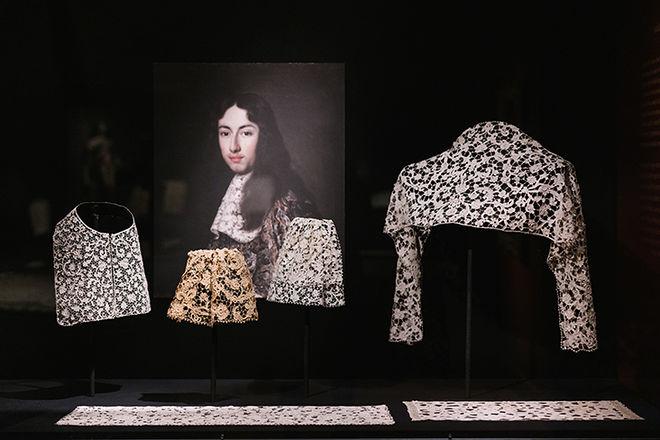
Photo by Da Ping Luo.
The Threads of Power: Lace from the Textilmuseum St. Gallen experience includes something for everyone, in the gallery or from the comfort of home. We invite those who are unable to visit the installation in person to explore the online exhibition of the same name to view high-resolution photography and information about objects on display organized by theme and chronology, just as they are in the gallery. Simply click one of the seven themes listed, like Fashions in Lace at the Hapsburg Court or Postwar Fashion and Chemical Lace, and you can enjoy stunning photographs of the lace and garments in the exhibition, many of which allow you to zoom in to see greater detail. Explanations of the role of lace in history and fashion and information about the lives of lacemakers offer background about the use and production of this rarefied commodity. The online exhibition also includes videos of lacemaking in action, reflections on lace by contemporary artists and thinkers, and much more.
Whether you visit the gallery or the online exhibition, you can engage with and deepen your understanding of the themes presented in Threads of Power by listening to imaginative short stories and original music hidden throughout the exhibition in the Tracing Lace Story Tour, conceived and created by artists James Harrison Monaco and Janani Balasubramanian. This audio accompaniment is also available to enjoy from home.
For another perspective on the value and importance of lace, visit a kìí ṣẹ̀ṣọ́ gbélé (we do not dress up beautifully to sit at home) on the Gallery’s fourth floor. In this interactive micro-exhibition, you can look closely at a piece of Austrian-made Nigerian lace and listen to excerpts from a podcast that explores Nigerian fashion and the integral role lace plays in it, as well as the threads of history, culture, and industry that tie together Nigeria and Austria’s lace trade. Details and photographs of a kìí ṣẹ̀ṣọ́ gbélé are included in the online exhibition, as are the podcast episodes.
On Saturday and Sunday afternoons, you can visit the Lacemakers’ Studio, also on the fourth floor of the BGC Gallery, where lacemakers from Brooklyn Lace Guild demonstrate their craft. You might find Elena Kanagy-Loux, who created the beautiful red silk bobbin-lace collar that opens the exhibition, at work at her lace pillow. And if you can’t visit in person, you can enjoy photos of the Studio and learn more about the lacemakers who are eager to share their practice with Gallery visitors. You might even find an instructor if you would like to begin learning the craft yourself!
Finally, consider deepening your knowledge of lace by purchasing the Threads of Power exhibition catalogue. Tracing the history of lace in fashion from its sixteenth-century origins to the present, this richly illustrated publication offers a look at one of the world’s finest collections of historical lace and explores the longstanding connections between lace and status, addressing styles in lace worn at royal courts, including Habsburg Spain and Bourbon France, as well as lace worn by the elite ruling classes and Indigenous peoples in the Spanish Americas. Featuring new research, the catalogue covers a range of topics related to lace production, lace in fashion and portraiture, lace revivals, the mechanization of the lace industries in the nineteenth and twentieth centuries, and contemporary innovations in lace. With a focus on lace techniques, women lacemakers, and lace as a signifier of wealth and power, this sixteen-chapter book includes wide-ranging contributions by curators and experts from major museums and academic institutions enhanced by new photography of the objects on display in the exhibition.
